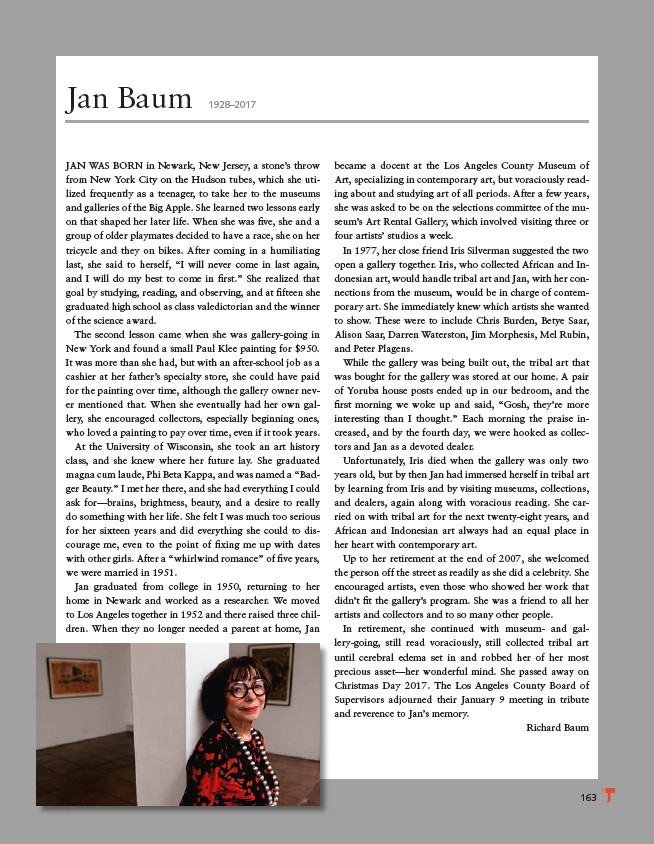
163
Jan Baum 1928–2017
JAN WAS BORN in Newark, New Jersey, a stone’s throw
from New York City on the Hudson tubes, which she utilized
frequently as a teenager, to take her to the museums
and galleries of the Big Apple. She learned two lessons early
on that shaped her later life. When she was fi ve, she and a
group of older playmates decided to have a race, she on her
tricycle and they on bikes. After coming in a humiliating
last, she said to herself, “I will never come in last again,
and I will do my best to come in fi rst.” She realized that
goal by studying, reading, and observing, and at fi fteen she
graduated high school as class valedictorian and the winner
of the science award.
The second lesson came when she was gallery-going in
New York and found a small Paul Klee painting for $950.
It was more than she had, but with an after-school job as a
cashier at her father’s specialty store, she could have paid
for the painting over time, although the gallery owner never
mentioned that. When she eventually had her own gallery,
she encouraged collectors, especially beginning ones,
who loved a painting to pay over time, even if it took years.
At the University of Wisconsin, she took an art history
class, and she knew where her future lay. She graduated
magna cum laude, Phi Beta Kappa, and was named a “Badger
Beauty.” I met her there, and she had everything I could
ask for—brains, brightness, beauty, and a desire to really
do something with her life. She felt I was much too serious
for her sixteen years and did everything she could to discourage
me, even to the point of fi xing me up with dates
with other girls. After a “whirlwind romance” of fi ve years,
we were married in 1951.
Jan graduated from college in 1950, returning to her
home in Newark and worked as a researcher. We moved
to Los Angeles together in 1952 and there raised three children.
When they no longer needed a parent at home, Jan
became a docent at the Los Angeles County Museum of
Art, specializing in contemporary art, but voraciously reading
about and studying art of all periods. After a few years,
she was asked to be on the selections committee of the museum’s
Art Rental Gallery, which involved visiting three or
four artists’ studios a week.
In 1977, her close friend Iris Silverman suggested the two
open a gallery together. Iris, who collected African and Indonesian
art, would handle tribal art and Jan, with her connections
from the museum, would be in charge of contemporary
art. She immediately knew which artists she wanted
to show. These were to include Chris Burden, Betye Saar,
Alison Saar, Darren Waterston, Jim Morphesis, Mel Rubin,
and Peter Plagens.
While the gallery was being built out, the tribal art that
was bought for the gallery was stored at our home. A pair
of Yoruba house posts ended up in our bedroom, and the
fi rst morning we woke up and said, “Gosh, they’re more
interesting than I thought.” Each morning the praise increased,
and by the fourth day, we were hooked as collectors
and Jan as a devoted dealer.
Unfortunately, Iris died when the gallery was only two
years old, but by then Jan had immersed herself in tribal art
by learning from Iris and by visiting museums, collections,
and dealers, again along with voracious reading. She carried
on with tribal art for the next twenty-eight years, and
African and Indonesian art always had an equal place in
her heart with contemporary art.
Up to her retirement at the end of 2007, she welcomed
the person off the street as readily as she did a celebrity. She
encouraged artists, even those who showed her work that
didn’t fi t the gallery’s program. She was a friend to all her
artists and collectors and to so many other people.
In retirement, she continued with museum- and gallery
going, still read voraciously, still collected tribal art
until cerebral edema set in and robbed her of her most
precious asset—her wonderful mind. She passed away on
Christmas Day 2017. The Los Angeles County Board of
Supervisors adjourned their January 9 meeting in tribute
and reverence to Jan’s memory.
Richard Baum